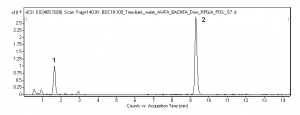Quercetin and Isoquercetin Separated with HPLC
The Amazon rainforest is the most biodiverse region in the world. Over one quarter of natural medicines have been found in rainforests, and new species are constantly being discovered. Therefore, there is a need for analytical study of the indigenous flora and fauna in developing new pharmaceuticals. In some cases, natives of the region have traditionally consumed these natural products for their therapeutic effects but the active ingredients themselves may be still undetermined. One example is the “rose of Venezuela” tree (Brownea grandiceps), in which the bark is added to boiled water and the resulting extract is consumed as a tea. Among other beneficial effects, the beverage is believed to exhibit hemostatic and antidiabetic properties.
In order to identify some of its chemical components, a bark extract of Brownea grandiceps was analyzed with the Cogent Diamond Hydride™ and Cogent Bidentate C18™ Columns. Together these two Columns can cover retention for a wide spectrum of Polar and non-Polar compounds.
In a complex natural product such as a bark extract, they are excellent Column choices for a thorough analytical investigation. The Columns can be used in Reversed Phase (RP) and Aqueous Normal Phase (ANP) modes to obtain separation for the various compounds that may be found in the extract. In addition to being sold individually, they are also available together in our convenient Cogent™ Metabolomics Kit.
Download full details of this study, including Method Conditions by clicking on the link below.

1. Quercetin m/z 303.0499 [M + H]+
2. Isoquercetin m/z 465.1028 [M + H]+
Attachment
Advantages of Cogent HPLC Columns for Analyzing Amazonian Bark Extract pdf 0.4 Mb Download this file


